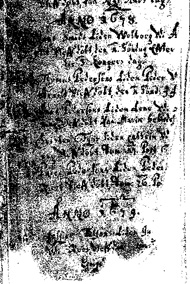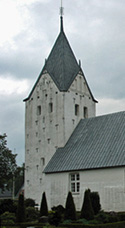Petersen and other patronyms in Denmark

None of them were famous. None of them were wealthy. Our earliest Danish ancestors were poor and humble, metal-smiths or tailors, cottage-farmers and glaziers whose families were often large to make sure enough children would survive to adulthood. When surnames (rather than patronyms) became mandatory in the 1800s our ancestors adopted Petersen, but before that they possessed a passel of patronyms.
As a result the earliest documented ancestor whom we know from this rgion was called Hans Smid. We won't see an actual surname Petersen until 1822, when patronymic naming conventions gave way to a royal decree.
At this historical point in Denmark surnames were not used. Instead children usually had patronyms fashioned after the first name of their father, so the son of Hans would be Hansen, the daughter would be Hansdatter. In the case of our Hans Smid, he employs an occupational name, suggesting that he was a smith. Sometimes occupation names were used in cases where the parish priest wanted to distinguish one Hans from another identically named Hans in the same parish.
Hans Smid was born sometime around 1640-1650 in Arrild parish, Hviding district, Tønder county in the southwest corner of Denmark. His wife, Karin Pedersdatter, whom he married in 1673, was likely around the same age. Marriage around ages 25 to 30 was common at that time, but the records only tell us names and year of the event. No ages are recorded. In baptism records from this time in Denmark only the father's name is given, not the mother's, which makes researching these folks a real challenge, but here at least we have a marriage record to tell us who was the mother of Hans' two daughters.

We know almost nothing more about Hans Smid's origins because the church books for his region are available only from 1659 onwards. Some pages are damaged or frayed (see the example above). But we do know that Hans and Karin had two daughters: Else, born in 1675, and Wolborg, born in 1678. Hans died in 1680 when his daughters were still young, but no reason for his death is recorded. These are very cryptic records!
Wolborg Hansdatter, whose name suggests a reference to eighth-century historical figure St. Walpurga, married a fellow called Tÿgge, Danish for Tycho, whose patronym is written either as Jacobsen or Jörgensen. He was from the nearby village of Objerg but he and Wolborg were married in 1719 in Arrild, her parish, as was the custom at that time. The church still exists and is pictured at left.
Tÿgge is also our earliest male ancestor whose genetic DNA has been tested via one of his male descendants. Genetic genealogy allows us to trace deep ancestral origins. This paternal line is from a genetic group, or haplogroup, called G2a3b, originating between 8,000 - 10,000 years ago in the northern Middle East. This is a very rare haplogroup for Denmark, occurring in only 2% of Danes. For more information about the rare G haplogroup, check Ray Bank's pages.
Tÿgge's and Wolborg's son Christian Tygesen was born in 1720 in Objerg. Christian's occupation isn't recorded but we do know that he married Margrethe Hansdatter (not related to Wolberg, this is just a patronym) in the nearby town of Øster Lindet in Haderslev in 1736.
Christian's and Margrethe's son, Hans Christian Christiansen, was born in the nearby village of Stenderup, Haderslev. His 1773 marriage to Bodil Marie Hansdatter was followed by the birth of a son, Peder Hansen, in 1774. Hans was a tailor, as was his son Peder. Remember that name: Peder Hansen. It will come up again shortly.
To follow his story and that of our more recent relatives, click here for Petersen Part 2.